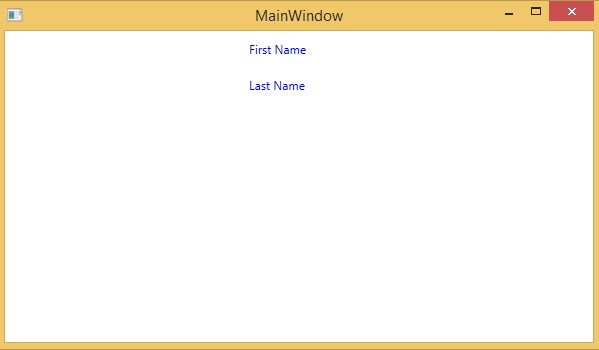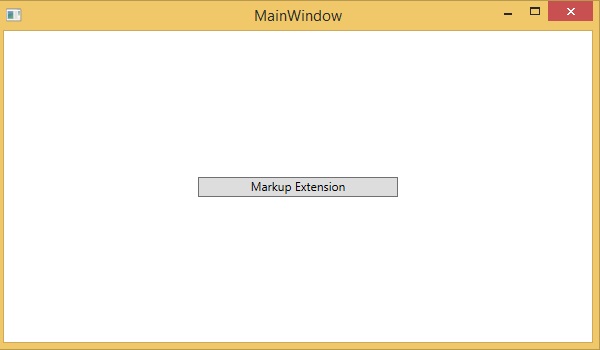
- XAML - Home
- XAML - Overview
- XAML - Environment Setup
- Writing XAML Aplication On MAC OS
- XAML Vs C# Code
- XAML Vs.VB.NET
- XAML - Building Blocks
- XAML - Controls
- XAML - Layouts
- XAML - Event Handling
- XAML - Data Binding
- XAML - Markup Extensions
- XAML - Dependency Properties
- XAML - Resources
- XAML - Templates
- XAML - Styles
- XAML - Triggers
- XAML - Debugging
- XAML - Custom Controls
XAML - Markup Extensions
In XAML applications, markup extensions are a method/technique to gain a value that is neither a specific XAML object nor a primitive type. Markup extensions can be defined by opening and closing curly braces and inside that curly braces, the scope of the markup extension is defined.
Data binding and static resources are markup extensions. There are some predefined XAML markup extensions in System.xaml which can be used.
Lets have a look at a simple example where StaticResources markup extension is used which is a predefined XAML markup extension.
The following XAML code creates two text blocks with some properties and their foreground is defined in Window.Resources.
<Window x:Class = "XAMLStaticResourcesMarkupExtension.MainWindow"
xmlns = "http://schemas.microsoft.com/winfx/2006/xaml/presentation"
xmlns:x = "http://schemas.microsoft.com/winfx/2006/xaml"
Title = "MainWindow" Height = "350" Width = "525">
<Window.Resources>
<SolidColorBrush Color = "Blue" x:Key = "myBrush"></SolidColorBrush>
</Window.Resources>
<Grid>
<StackPanel Orientation = "Vertical">
<TextBlock Foreground = "{StaticResource myBrush}" Text = "First Name"
Width = "100" Margin = "10" />
<TextBlock Foreground = "{StaticResource myBrush}" Text = "Last Name"
Width = "100" Margin = "10" />
</StackPanel>
</Grid>
</Window>
In Window.Resources, you can see x:Key is used which uniquely identifies the elements that are created and referenced in an XAML defined dictionary to identify a resource in a resource dictionary.
When you compile and execute the above code, it will produce the following MainWindow. You can see the two text blocks with blue foreground color.

In XAML, custom markup extensions can also be defined by inheriting MarkupExtension class and overriding the ProvideValue method which is an abstract method in the MarkupExtension class.
Lets have a look at a simple example of custom markup extension.
<Window x:Class = "XAMLMarkupExtension.MainWindow"
xmlns = "http://schemas.microsoft.com/winfx/2006/xaml/presentation"
xmlns:x = "http://schemas.microsoft.com/winfx/2006/xaml"
xmlns:my = "clr-namespace:XAMLMarkupExtension"
Title = "MainWindow" Height = "350" Width = "525">
<Grid>
<Button Content = "{my:MyMarkupExtension FirstStr = Markup, SecondStr = Extension}"
Width = "200" Height = "20" />
</Grid>
</Window>
In the above XAML code, a button is created with some properties and for the content value, a custom markup extension (my:MyMarkupExtension) has been used with two values Markup and Extension which are assigned to FirstStr and SecondStr respectively.
Actually, MyMarkupExtension is a class which is derived from MarkupExtension as shown below in the C# implementation. This class contains two string variables, FirstStr and SecondStr, which are concatenated and return that string from the ProvideValue method to the Content of a button.
using System;
using System.Collections.Generic;
using System.Linq;
using System.Text;
using System.Threading.Tasks;
using System.Windows;
using System.Windows.Controls;
using System.Windows.Data;
using System.Windows.Documents;
using System.Windows.Input;
using System.Windows.Markup;
using System.Windows.Media;
using System.Windows.Media.Imaging;
using System.Windows.Navigation;
using System.Windows.Shapes;
namespace XAMLMarkupExtension {
/// <summary>
/// Interaction logic for MainWindow.xaml
/// </summary>
public partial class MainWindow : Window {
public MainWindow() {
InitializeComponent();
}
}
public class MyMarkupExtension : MarkupExtension {
public MyMarkupExtension() { }
public String FirstStr { get; set; }
public String SecondStr { get; set; }
public override object ProvideValue(IServiceProvider serviceProvider) {
return FirstStr + " " + SecondStr;
}
}
}
Let's run this application and you can see immediately in our MainWindow that "markup extension" has been successfully used as the content of the button.
